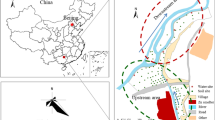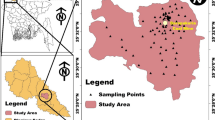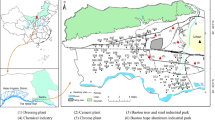Abstract
In this paper, the 36 topsoil (0–10 cm) samples were collected and the contents of Cr, Mn, Co, Ni, Cu, Zn, As, Cd and Pb were analyzed. The results indicated that the contents of Cu and As in all samples exceeded the soil background values of Anhui province, while the Co and Pb contents were lower than the background values. Geo-statistics and positive matrix factorization were applied to identify the sources of soil heavy metals, which were nature factor (15.7%), industrial activities (21.2%), coal mine (50.9%) and traffic emission (12.2%), respectively. The calculation results of health risk model based on positive matrix factorization model showed that coal mine activities accounted for the largest proportion of total source contribution, followed by industrial activities. In addition, compared with adults, the trend of health risk of children from four sources in three lands were same as adults, but their health risk was higher than adults.

Similar content being viewed by others
Abbreviations
- HMs:
-
Heavy metals
- W.A:
-
Wasteland A
- W.B:
-
Wasteland B
- F.C:
-
Farmland C
- PMF:
-
Positive matrix factorization
References
Akoto O, Bismark Eshun F, Darko G, Adei E (2014) Concentrations and health risk assessments of heavy metals in fifish from the Fosu Lagoon. Int J Environ Res 8(2):403–410
Bai J, Jia J, Zhang G, Zhao Q, Lu Q, Cui B, Liu X (2016) Spatial and temporal dynamics of heavy metal pollution and source identification in sediment cores from the short-term flooding riparian wetlands in a Chinese delta. Environ Pollut 219:379–388. https://doi.org/10.1016/j.envpol.2016.05.016
Brady JP, Ayoko GA, Martens WN, Goonetilleke A (2015) Development of a hybrid pollution index for heavy metals in marine and estuarine sediments. Environ Monit Assess 187(5):1–14
Castro-Gonzalez N, Calderon-Sanchez F, Moreno-Rojas R, Moreno-Ortega A, Tamariz-Flores JV (2017) Health risks in rural populations due to heavy metals found in agricultural soils irrigated with wastewater in the Alto Balsas subbasin in Tlaxcala and Puebla. Mexico Int J Environ Health Res 27:476–486
Dai Bin L, Jian-shu Z-C et al (2015) Assessment of sources, spatial distribution and ecological risk of heavy metals in soils in a typical industry-based city of Shandong Province. Eastern China Environ Sci 2:507–515
Duan J, Tan J (2013) Atmospheric heavy metals and Arsenic in China: situation, sources and control policies. Atmos Environ 74(2):93–101. https://doi.org/10.1016/j.atmosenv.2013.03.031
Environmental monitoring station in China (1990) Background value of soil elements in China. Environmental Science Press in China, Beijing, pp 342–482
Fan W, Zhou J, Zhou Y et al (2019) Heavy metal pollution and health risk assessment of agricultural land in the Southern Margin of Tarim Basin in Xinjiang, China. Int J Environ Health Res. https://doi.org/10.1080/09603123.2019.1691157
Fang H, Gui H, Yu H, Li J, Chen C (2020) Characteristics and source identification of heavy metals in abandoned coal-mining soil: a case study of zhuxianzhuang coal mine in huaibei coalfield (anhui, china). Hum Ecol Risk Assess 3:1–16
Gong Q, Chen PZ, Shi RG, Gao Y, Zheng SA, Xu Y, Shao CF, Zheng XQ (2019) Health assessment of trace metal concentrations in organic fertilizer in Northern China. Int J Environ Res Public Health 16:1031
Huang J, Guo S, Zeng G-M, Li F, Gu Y, Shi Y, Shi L, Liu W, Peng S (2018) A new exploration of health risk assessment quantification from sources of soil heavy metals under different land use. Environ Pollut 243:45–58
Hjortenkrans D, Bo B, Häggerud A (2006) New metal emission patterns in road traffic environments. Environm Monit Assess 117(1/2/3):85–98
Hadzi GY, Ayoko GA, Essumang DK et al (2019) Contamination impact and human health risk assessment of heavy metals in surface soils from selected major mining areas in Ghana. Environ Geochem Health 41(6):2821–2843
Hemann JG, Brinkman GL, Dutton SJ, Hannigan MP, Milford JB, Miller SL (2009) Assessing positive matrix factorization model fifit: a new method to estimate uncertainty and bias in factor contributions at the measurement time scale. Atmos Chem Phys 9:497–513
Kim MS, Park MJ, Yang JH et al (2019) Human health risk assessment for toxic trace elements in the Yaro mine and reclamation options. Int J Environ Res Public Health 16(24):5077
Keshavarzi B, Najmeddin A, Moore F et al (2019) Risk-based assessment of soil pollution by potentially toxic elements in the industrialized urban and peri-urban areas of Ahvaz metropolis, southwest of Iran. Ecotoxicol Environ Saf 167:365–375
Lu Q, Wang S, Bai X et al (2020) Quantitative assessment of human health risks under different land uses based on soil heavy metal pollution sources. Hum Ecol Risk Assess. https://doi.org/10.1080/10807039.2019.1710811
Li Tao et al (2019) Source apportionment and source-to-sink transport of major and trace elements in coastal sediments: combining positive matrix factorization and sediment trend analysis. Sci Total Environ 651:344–356
Liu L, Li W, Song W, Guo M (2018) Remediation techniques for heavy metalcontaminated soils: principles and applicability. Sci. Total Environ 633:206219
Feng-zhi L, Yu-jin Li (2015) Soil monitoring and analysis technology. Chemical Industry Press, Beijing
Lv JS, Zhang ZL, Li S et al (2014) Assessing spatial distribution, sources, and potential ecological risk of heavy metals in surface sediments of the Nansi Lake, Eastern China. J Radio Anal Nucl Chem 299(3):1671–1681
Liang J, Feng C, Zeng G et al (2017) Spatial distribution and source identification of heavy metals in surface soils in a typical coal mine city, Lianyuan, China. Environ Pollut 225:681–690
Ferreira-Baptista L, De Miguel E (2005) Geochemistry and risk assessment of street dust in Luanda, Angola: a tropical urban environment. Atmos Environ 39(25):4501–4512
Men C, Liu R, Xu F, Wang Q, Guo L, Shen Z (2018) Pollution characteristics, risk assessment, and source apportionment of heavy metals in road dust in Beijing. China Sci Total Environ 612:138–147. https://doi.org/10.1016/j.scitotenv.2017.08.123
Mitra P, Sharma S, Purohit P et al (2017) Clinical and molecular aspects of lead toxicity: an update. Crit Rev Clin Lab Sci 54(7–8):1–23
Ma W, Tai L, Qiao Z, Zhong L, Wang Z, Fu K, Chen G (2018) Contamination source apportionment and health risk assessment of heavy metals in soil around municipal solid waste incinerator: a case study in North China. Sci Total Environ 631:348–357
Norris GA, Duvall R, Brown SG, Bai S (2014) EPA Positive Matrix Factorization (PMF) 5.0 Fundamentals and User Guide Prepared for the US. Environmental Protection Agency Office of Research and Development, Washington, DC. DC. EPA/600/R-14/108.
Patlolla AK, Todorov TI, Tchounwou PB et al (2012) Arsenic-induced biochemical and genotoxic effects and distribution in tissues of Sprague-Dawley rats. Microchem J 105:101–107
Peter AE, Nagendra SMS, Nambi IM (2018) Comprehensive analysis of inhalable toxic particulate emissions from an old municipal solid waste dumpsite and neighborhood health risks. Atmospheric Pollution Research 9(6):1021–1031
Tian L (2016) Study of composition profiles of soil and sources apportionment of heavy metals in farmland impacted by complex pollution sources. University of Chinese Academy of Sciences, Beijing
Tong G, Wu S, Yuan Y, Li F, Chen L, Yan D (2018) Modeling of trace metal migration and accumulation processes in a soil-wheat system in Lihe Watershed, China. Int J Environ Res Public Health 15(11):2432
US EPA (1989) Risk assessment guidance for superfund, Vol. I: human health evaluation manual. Washington, DC: Office of Emergency and Remedial Response
US EPA (1996) Soil screening guidance: Technical background document/superfund/USEPA. https://www.osti.gov/biblio/270219
US EPA (2002) Supplemental guidance for developing soil screening levels for superfund sites. Office of Emergency and Remedial Response, Washington, DC
US EPA (2011) Exposure Factors Handbook: 2011 Edition. National Center for Environmental Assessment Office of Research and Development U.S. Environmental Protection Agency, Washington, p. 20460 (EPA/600/R-09/052F)
Wang S, Cai L-M, Wen H-H, Luo J, Wang Q-S, Liu X (2019) Spatial distribution and source apportionment of heavy metals in soil from a typical county-level city of Guangdong Province. China Sci Total Environ 655:92–101
Wu SZ, Zhou S, Bao H et al (2019) Improving risk management by using the spatial interaction relationship of heavy metals and PAHs in urban soil. J Hazard Mater 364:108–116
Wu J, Lu J, Li L et al (2018a) Pollution, ecological-health risks, and sources of heavy metals in soil of the northeastern Qinghai- Tibet Plateau. Chemosphere 201:234–242
Wu J, Long J, Liu L et al (2018b) Risk assessment and source identification of toxic metals in the agricultural soil around a Pb/Zn mining and smelting area in Southwest China. Int J Environ Res Public Health 15(9):1838
Ji W, Shao-qin L et al (2008) Estimation of Chinese skin exposure area in health risk assessment. J Saf Environ 04:154–158
Xiong S, Gui H, Peng W (2016) Study on heavy metal pollution characteristics of farmland soil in mining area. J Suzhou Univ 31(12):102–108
Xiong S (2017). Study of content and migration characteristics of heavy metals in soil from Linhuan mining district. Anhui University of Science of Technology.
Yang Y, Christakos G, Guo M, Xiao L, Huang W (2017) Space-time quantitative source apportionment of soil heavy metal concentration increments. Environ Pollut 223:560–566. https://doi.org/10.1016/j.envpol.2017.01.058
Zhao L, Xu Y, Hou H et al (2014) Source identification and health risk assessment of metals in urban soils around the Tanggu chemical industrial district, Tianjin, China. Sci Total Environ 468–469:654–662
Zhao R et al (2019) Fuzzy synthetic evaluation and health risk assessment quantification of heavy metals in Zhangye agricultural soil from the perspective of sources. Sci Total Environ 697:134126
Zhao Z, Feng W, Zhang L (2017) Determination of 14 kinds of metal elements by ICP-MS about “Detailed investigation of soil pollution in China”. Environ Chem 36(2):448–452
Acknowledgements
This article is funded by National Training Program of Innovation and Entrepreneurship for Undergraduates, National Natural Science Foundation of China (41773100, 41373095), Research Project of Huaibei Mining Group Co. (2020) and Research Project of Wanbei Coal-electricity Group Co. Ltd (2020), and the University Natural Science Research Project of Anhui Province (KJ2017A445).
Author information
Authors and Affiliations
Contributions
HF conceived and wrote this paper; HG revised the manuscript and collected samples; HY, MW and JL provided technical assistance of graphs; YJ, CW, YZ, YH and CC sampled and performed the experiments.
Corresponding author
Additional information
Publisher's Note
Springer Nature remains neutral with regard to jurisdictional claims in published maps and institutional affiliations.
Supplementary Information
Below is the link to the electronic supplementary material.
Rights and permissions
About this article
Cite this article
Fang, H., Gui, H., Li, J. et al. Risks Assessment Associated with Different Sources of Metals in Abandoned Soil of Zhuxianzhuang Coal Mine, Huaibei Coalfield (Anhui, China). Bull Environ Contam Toxicol 106, 370–376 (2021). https://doi.org/10.1007/s00128-020-03069-4
Received:
Accepted:
Published:
Issue Date:
DOI: https://doi.org/10.1007/s00128-020-03069-4




